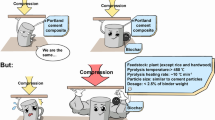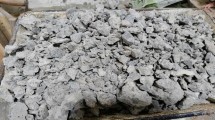Abstract
In this study, design of experiment methodology was applied to the optimization of mixing the proportions of standard ready-mixed concrete (SC). The mixture proportion modeled by using response surface methodology (RSM) was determined as the function of variables such as aggregate mixture ratio, water-to-cement ratio and the percentage of super plasticizer content. The results show that water-to-cementitious material ratio causing the highest variation in responses is the most important factor, and aggregate mixture ratio is designated as the second most important factor. The results show also that the responses of convection heat transfer coefficient and the percent of air content are significantly affected by the synergistic effect of linear term of water-to-cement ratio and the antagonistic effect of quadratic term of water-to-cement ratio. Early comprehensive strength is significantly affected by the synergistic effect of linear term of ratio of water to cement materials and the synergistic effect of linear terms of aggregate mixture rate. Finally, three variables formulated using regression analyses were simultaneously optimized by utilizing RSM-based desirability function method.
Similar content being viewed by others
Abbreviations
- A :
-
Heat transfer surface area (m 2)
- \({^{\circ}{\rm C}}\) :
-
Centigrade degree
- L :
-
Sample length (m)
- h̄ c :
-
Average convection heat transfer coefficient (W/m2*K)
- h c :
-
Convection heat transfer coefficient (W/m2*K)
- K:
-
Kelvin
- k :
-
Thermal conductivity (W/m \({^{\circ}{\rm C}}\))
- Q :
-
Total heat loss
- SC:
-
Standard concrete
- SP:
-
Superplasticizer
- \({T_{\omega}}\) :
-
Concrete surface temperature (K)
- \({T_{\infty}}\) :
-
Ambient temperature (K)
- \({\upsilon}\) :
-
Kinematic viscosity (m2/s)
References
Yan S., Lin H.C., Liu Y.C.: Optimal schedule adjustments for supplying ready mixed concrete following incidents. Automat. Constr. 20, 1041–1050 (2011)
Chang C.Y., Huang R., Lee P.C., Weng T.L.: Application of a weighted Grey-Taguchi method for optimizing recycled aggregate concrete mixtures. Cem. Concr. Compos. 33, 1038–1049 (2011)
Alani A., Faramarzi A.: An evolutionary approach to modeling concrete degradation due to sulphuric acid attack. Appl. Soft Comput. 24, 985–993 (2014)
Hewayde E., Nehdi M., Allouche E., Nakhla G.: Neural network prediction of concrete degradation by sulphuric acid attact. Struct. Infrastruct. Eng. 3, 17–27 (2007)
Tanyıldızı H., Çevik A.: Modeling mechanical performance of lightweight concrete containing silica fume exposed to high temperature using genetic programming. Constr. Build. Mater. 24, 2612–2618 (2010)
Güler K., Demir F., Pakdamar F.: Stress–strain modelling of high strength concrete by fuzzy logic approach. Constr. Build. Mater. 37, 680–684 (2012)
Bal L., Bodin F.B.: Artificial neural network for predicting drying shrinkage of concrete. Constr. Build. Mater. 38, 248–254 (2013)
Hinislioglu S., Bayrak O.U.: Optimization of early flexural strength of pavement concrete with silica fume and fly ash by the Taguchi method. Civil Eng. Environ. Syst. 1(2), 79–90 (2004)
Muthukumar M., Mohan D.: Optimization of mechanical properties of polymer concrete and mix design recommendation based on design of experiments. J. Appl. Polym. Sci. 94, 1107–1117 (2004)
Tan O., Zaimoglu A.S., Hinislioglu S., Altun S.: Taguchi approach for optimization of the bleeding on cement-based grouts. Tunn. Undergr. Space Technol. 20(2), 167–173 (2005)
Turkmen I., Gul R., Celik C., Demirboga R.: Determination by Taguchi method of optimum conditions for mechanical properties of high strength concrete with admixtures of silica fume and blast furnace slag. Civil Eng. Environ. Syst. 20(2), 105–118 (2003)
Fauzan K.T., Hosino M., Morita A.: The influence of mixing techniques on the properties of concrete by using air entraining agent and high range water reducer agent. Jurnal Itenas 7(3), 1–10 (2003)
Ozbay E., Oztas A., Baykasoglu A., Ozbebek H.: Investigating mix proportions of high strength self compacting concrete by using Taguchi method. Constr. Build. Mater. 23, 694–702 (2009)
Olivia M., Nikraz H.: Properties of fly ash geopolymer concrete designed by Taguchi method. Mater. Des. 36, 191–198 (2012)
Bayramov F., Taşdemir C., Taşdemir M.A.: Optimisation of steel fibre reinforced concretes by means of statistical response surface method. Cem. Concr. Compos. 26, 665–675 (2004)
Nambiar E.K.K., Ramamurthy K.: Models relating mixture composition to the density and strength of foam concrete using response surface methodology. Cem. Concr. Compos. 28, 752–760 (2006)
Mohammed B.S., Fang O.C., Hossain KMA, Lachemi M.: Mix proportioning of concrete containing paper mill residuals using response surface methodology. Constr. Build. Mater. 35, 63–68 (2012)
Bektaş F., Bektaş B.A.: Analyzing mix parameters in ASR concrete using response surface methodology. Constr. Build. Mater. 66, 299–305 (2014)
Li Q., Cai L., Fu Y., Wang H., Zou Y.: Fracture properties and response surface methodology model of alkali-slag concrete under freeze–thaw cycles. Constr. Build. Mater. 93, 620–626 (2015)
Zamani H., Moghima M., Kianifar A.: Optimization of the parabolic mirror position in a solar cooker using the response surface method (RSM). Renew. Energy 81, 753–759 (2015)
Saravanathamizhan R., Vardhan K.H., Gnana D.P., Balasubramanian N.: RSM and ANN modeling for electro-oxidation of simulated wastewater using CSTER. Desalination Water Treat. 55(6), 1445–1452 (2015)
Bai Y., Saren G., Huo W.: Response surface methodology (RSM) in evaluation of the vitamin C concentrations in microwave treated milk. J. Food Sci. Technol. 52(7), 4647–4651 (2015)
Cho H., Zoh D.K.: Photocatalytic degradation of azo dye (Reactive Red 120) in TiO2/UV system: Optimization and modeling using a response surface methodology (RSM) based on the central composite design. Dyes Pigments 75, 533–543 (2007)
Carley, K.M.; Kamneva, N.Y.; Reminga, J.: Response Surface Methodology CASOS—Center for Computational Analysis of Social and Organizational Systems, Technical Report, ISRI—Institute for Software Research International. Carnegie Mellon University, 04-136 (2004)
Myers R.H., Montgomery D.C.: Response Surface Methodology: process and product optimization using designed experiment. Wiley, (2002)
Habib S.S.: Study of the parameters in electrical discharge machining through response surface methodology approach. Appl. Math. Model. 33, 4397–4407 (2009)
Baş D., Boyacı İ.H.: Modeling and optimization. I. Usability of response surface methodology. J. Food Eng. 78, 836–845 (2007)
Khuri I.A., Cornell A.J.: Response Surfaces: Designs and Analyses, 2nd ed. Marcel Dekker Inc, NY (1996)
MINITAB R17 Support. Internet: http://support.minitab.com/en-us/minitab/17/topic-library/modeling-statistics/doe/response-surface-designs/what-is-a-response-surface-design/
Şimşek B., İç Y.T., Şimşek E.H., Güvenç A.B.: Development of a graphical user interface for determining the optimal mixture parameters of normal weight concretes: a response surface methodology based quadratic programming approach. Chemom. Intell. Lab. Syst. 136, 1–9 (2014)
Şimşek B., İç Y.T., Şimşek E.H.: A full factorial design based desirability function approach for optimization of properties of C 40/50 concrete class. Math. Comput. Appl. 18(3), 330–339 (2013)
Şimşek, B.: A Multi-Response Optimization and Modeling Application for Determining Optimal Mix Proportions o Ready-Mixed Concrete: Response Surface Methodology (RSM) with A TOPSIS based Taguchi Approach [dissertation: In Turkish]. Ankara University, Ankara, p. 207 (2014)
Şimşek B., İç Y.T., Şimşek E.H.: A TOPSIS-based Taguchi optimization to determine optimal mixture proportions of the high strength self-compacting concrete. Chemom. Intell. Lab. Syst. 125, 18–32 (2015)
EN 12350/2: Testing Fresh Concrete—Part 5, Flow Table Test. Ankara, Turkish Standardization Institute, pp. 1–10 (In Turkish) (2010a)
EN 206-1: Concrete—Part 1: Specification, Performance, Production and Conformity, Turkish Standardization Institute, Ankara (in Turkish) (2002)
EN 12390/3: Testing Hardened Concrete—Part 3, Compressive Strength of TestSpecimens, Turkish Standardization Institute, Ankara (in Turkish) (2010)
EN 12390-6: Testing Hardened Concrete—Part 6, Determination of Splitting Tensile Strength of Concrete Specimens, Turkish Standardization Institute, Ankara (in Turkish) (2002)
Buyukalaca O., Bulut H.: Detailed weather data for the provinces covered by the Southeastern Anatolia Project (GAP) of Turkey. Appl. Energy 77, 187–204 (2004)
Uygunoğlu T., Keçebaş A.: LCC analysis for energy-saving in residential buildings with different types of construction masonry blocks. Energy Build. 43, 2077–2085 (2011)
Lee Y., Choi M.S., Yi S.T., Kim J.K.: Experimental study on the convective heat transfer coefficient of early-age concrete. Cem. Concr. Compos. 31, 60–71 (2009)
Al-Homoud M.S.: Performance characteristics and practical applications of common building thermal insulation materials. Build. Environ. 40, 353–366 (2005)
Mohammed H.A., Salman H.Y.: Free and forced convection heat transfer in the thermal entry region for laminar flow inside a circular cylinder horizontally oriented. Energy Convers. Manag. 48, 2185–2195 (2007)
EN 12390-7: Testing Hardened Concrete—Part 7, Density of Hardened Concrete, Turkish Standardization Institute, Ankara (in Turkish) (2010)
Holman J.P.: Heat transfer, 10th ed. McGraw Hill Company, NY (2010)
Kleijnen J.P.C., Sargent R.G.: A methodology for fitting and validating metamodels in simulation. Eur. J. Oper. Res. 120, 14–29 (2000)
Derringer G., Suich R.: Simultaneous optimization of several response variables. J. Qual. Technol. 12(4), 214–219 (1980)
Harrington E.C.: The desirability function. Ind. Qual. Control 21(10), 494–498 (1965)
Kovach J., Cho B.R.: A D-optimal design approach to constrained multiresponse robust design with prioritized mean and variance considerations. Comput.Ind. Eng. 57, 237–245 (2009)
Jeong I.J., Kim K.J.: An interactive desirability function method to multiresponse optimization. Eur. J. Oper. Res. 195, 412–426 (2009)
Author information
Authors and Affiliations
Corresponding author
Rights and permissions
About this article
Cite this article
Şimşek, B., İç, Y.T. & Şimşek, E.H. A RSM-Based Multi-Response Optimization Application for Determining Optimal Mix Proportions of Standard Ready-Mixed Concrete. Arab J Sci Eng 41, 1435–1450 (2016). https://doi.org/10.1007/s13369-015-1987-0
Received:
Accepted:
Published:
Issue Date:
DOI: https://doi.org/10.1007/s13369-015-1987-0




